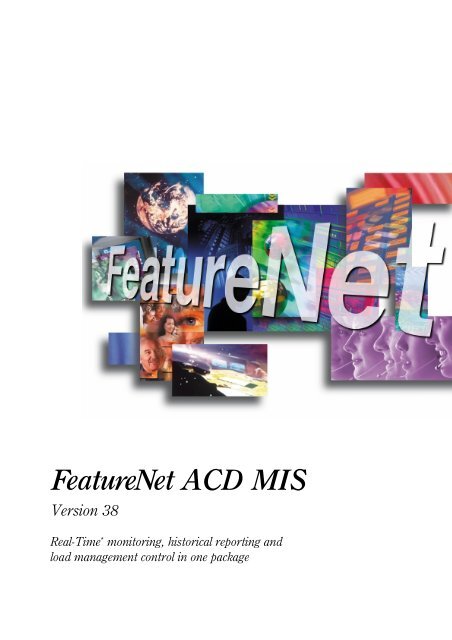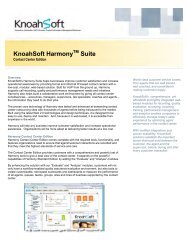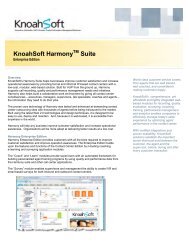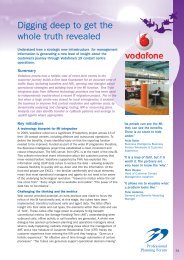FeatureNet ACD MIS - QPC
FeatureNet ACD MIS - QPC
FeatureNet ACD MIS - QPC
You also want an ePaper? Increase the reach of your titles
YUMPU automatically turns print PDFs into web optimized ePapers that Google loves.
<strong>FeatureNet</strong> <strong>ACD</strong> <strong>MIS</strong>Version 38Real-Time * monitoring, historical reporting andload management control in one package
<strong>FeatureNet</strong> <strong>ACD</strong> <strong>MIS</strong><strong>FeatureNet</strong> <strong>ACD</strong> <strong>MIS</strong>Call centre managementView <strong>FeatureNet</strong> <strong>ACD</strong> operationswith <strong>FeatureNet</strong> <strong>ACD</strong> ManagementInformation System (<strong>MIS</strong>).<strong>FeatureNet</strong> <strong>ACD</strong> <strong>MIS</strong> bringscomplete Real-Time* monitoring,historical reporting, and Real-Timeconfiguration (Load Management)control to your fingertips in onepackage.Supervisors and agents can view traffic conditions at a glanceand take more responsibility for quality and serviceEfficiency and reliability are keyto the success of all call centreoperations. <strong>FeatureNet</strong> <strong>ACD</strong> <strong>MIS</strong>combines with the <strong>FeatureNet</strong> 5000<strong>ACD</strong> service to bring these criteriato reality.SalesServiceReal-Time colourgraphic displaysThe key to <strong>ACD</strong> performancemanagement is receiving importantinformation as it occurs.<strong>FeatureNet</strong> <strong>ACD</strong> <strong>MIS</strong> continuouslyupdated colour graphic screenssimultaneously present queue andagent data for efficient analysis ofcall activity and staff performance.Specifically, detail and summaryinformation is available onindividual agents and groups,as well as on inbound/outboundtraffic.<strong>ACD</strong> <strong>MIS</strong>host<strong>FeatureNet</strong>switch<strong>MIS</strong>datastreamLED wallboardSystemprinterFaxmodemLocalprinter<strong>ACD</strong> <strong>MIS</strong>remote terminalLED wallboard* Throughout this document Real-Timemeans that under normal operatingconditions updates will occur withina maximum of 3 seconds.2
PermissionsAn access control structure tied touser login name allows the systemadministrator to tailor feature,display and device access for eachuser. Information shown on displayscreens and indicated in reportscan be limited to one, several or all<strong>ACD</strong> Groups within the system.Each user can be given access toone or more output devices,including printers and fax modems.Flexible outputsThe <strong>FeatureNet</strong> <strong>ACD</strong> <strong>MIS</strong> interfaceswith a variety of output devices,including dot matrix and laserprinters, external displays, fax andprinter modems. Print queuemanagement allows users tomonitor, pause and cancel printjobs.Line of business andclosed key codesUsing three-digit programmableline of business codes, agents canenter specific account codesor category identifiers for any<strong>ACD</strong> call. Using the Closed KeyWalkaway function, the <strong>FeatureNet</strong><strong>ACD</strong> <strong>MIS</strong> system can track anagent’s closed-key (unavailable)state as well.• Increased call completions• Lower network costs• Improved customer satisfaction• Improved agent productivity3
<strong>FeatureNet</strong> <strong>ACD</strong> <strong>MIS</strong><strong>FeatureNet</strong> <strong>ACD</strong> <strong>MIS</strong> gives you thetools to quickly analyse call centreperformance from one Real-Timedisplay screen.Call & queue dataIncoming call activityF2 – Show agent detailF8 – Expanded agent detailReal-Time displayReal-Time displayUnlike most systems which presentdata in tabular form, <strong>FeatureNet</strong><strong>ACD</strong> <strong>MIS</strong> uses colour graphics.A manager can instantly recognisethat calls are stacking up. On thesame screen, the manager canquickly identify which agents canbecome available to answer calls.Colour displays allow managersto react quickly to waiting callersbefore they abandon.Screen configurationEach user can reconfigure theinformation shown on theReal-Time Display. Variablesinclude the height of Upper andLower Windows, as well as theorder and appearance of data fieldsin the Upper and Lower Databoxes.Main menuA series of drop-down menusprovides instant access to menufunctions from the Real-TimeDisplay. All administrative andreporting tasks are accomplishedvia the menus. A Menu Bar acrossthe top of the Real-Time Displaysimplifies access to the Main Menu,screen configuration functions andsystem information.Example of Real-Time display withinthe GUI remote terminal software.User defined alarms<strong>FeatureNet</strong> <strong>ACD</strong> <strong>MIS</strong> can displayalarms whenever predetermineduser performance levels are notmet. For example, acceptableservice quality parameters canbe set at 90% of all calls answeredin 15 seconds or less.If this parameter is exceeded,the system responds with a visualalarm (colour change). Problemsthat might otherwise be overlookedare thus highlighted for‘corner of the eye’ identification.Monitor groupsA group of agents from various<strong>ACD</strong> Groups may be created formonitoring by a supervisor otherthan the one associated with theagent’s original <strong>ACD</strong> Group.This feature supports trainingof new agents. Monitor Groupsappear on the Real-Time Displayand become a sort parameter forhistorical reports. Separate alarmscan be set for Monitor Groups.4
Real-Time information display categories<strong>ACD</strong> Groups/QueuesGrade of Service (GOS)Average Speed of Answer (ASA)Calls OfferedCalls AnsweredNumber of Calls Overflowed InNumber of Calls Overflowed OutExpected DelayLongest DelayNumber of Agents Busyon Incoming CallsTotal Number of Calls AbandonedNumber of Calls Abandoned– Before Announcement– After Announcement2Calls PresentedPrimary Outgoing CallsSecondary Incoming CallsSecondary Outgoing CallsCall LoadDeflected CallsPercentage Calls AbandonedPercentage Calls Abandoned– Before Announcement– After AnnouncementAgent Groups and AgentsNumber of Agents Busy– Incoming Primary DN– Incoming Secondary DN– Outgoing Secondary DNNumber of Agents Ready (Available)Number of Positions UnattendedNumber of Agents in Wrap-Upand Variable Wrap-UpNumber of Calls Answered AfterBeing Recalled from Park or TransferOccupancyAverage timesBusy IncomingBusy OutgoingWrap-UpRecallAvailable (Ready)All Positions BusyHold Busy– Incoming Primary DN– Incoming Secondary DN– Outgoing Secondary DNGUI remote terminalsoftwareVersion 38 introduces aWindows-based Real-Timedisplay providing an easy to useand view data screen to enable:■ simpler and more effectivescreen manipulation■ user configurable screen layoutsto ensure the data required byindividual users can be easilyviewed.5
<strong>FeatureNet</strong> <strong>ACD</strong> <strong>MIS</strong>ReportsHistorical reporting<strong>FeatureNet</strong> <strong>ACD</strong> <strong>MIS</strong> historicalreporting capability measures yoursuccess at reaching service qualityobjectives by monitoring theperformance of personnel andequipment, determining how thestaff is adjusting to the workload,and identifying peak and lag timesfor better utilisation of personnel.The system is capable of storingdetail and/or summary data forseveral months. Reports use plainEnglish, not confusing acronyms.<strong>FeatureNet</strong> <strong>ACD</strong> <strong>MIS</strong> provides 39standard report formats detailing<strong>ACD</strong> activity. The GUI remoteterminal software provides 76 reportformats. Reports are generatedbased on user selected sort anddate/time parameters, deliveringover 1,600 possible combinations.The menu-driven interface displaysonly those reporting optionsavailable to a user login name.Reports may be displayed to thescreen, printed or faxed.Report groupsThis feature provides a convenientway to maintain a list of reportsthat can be scheduled to printautomatically. Users create/editreport groups and schedule them toprint immediately, hourly, daily,monthly or once only.<strong>FeatureNet</strong> <strong>ACD</strong> <strong>MIS</strong> standard report formatsIncoming call reportsIncoming Calls Waiting ReportIncoming Calls Abandoned ReportIncoming Call Duration ReportIncoming Call Termination ReportIncoming Traffic Analysis ReportIncoming Calls ReportIncoming Calls Waiting GraphicReportIncoming Calls Abandoned GraphicReport<strong>ACD</strong> group reportsDemand and Resource ReportWorkload Summary ReportWorkload Detail ReportOverflow Analysis ReportOverflow Interval ReportAll Positions Busy ReportQueue Busy ReportTime Delay Overflow Analysis ReportTime Delay Overflow Interval ReportTransfer Analysis ReportTransfer Interval ReportGroup Primary DN Activity GraphicReportGroup Full Activity Graphic ReportAgent reportsAgent ReportAgent Detail ReportAgent Performance ReportShort Calls ReportAgent Trace ReportAgent Primary DN Activity GraphicReportAgent Full Activity Graphic ReportAgent Deviation Graphic ReportLine of business code reportsLOB Summary ReportLOB Detail ReportLOB Agent vs Group ReportLOB Graphic ReportClosed key walkaway codereportsCKW Summary ReportCKW Detail ReportCKW Agent vs Group ReportCKW Graphic ReportVirtual facility group reportsVFG Summary ReportVFG Detail ReportDatabase table exportThis feature extracts historicaldata from the report database,reformats it into Comma SeparatedValues (CSV) file format, andcopies it to a DOS formatted floppydiskette or hard disk. CSV filesmay be readily imported into aspreadsheet program such asMicrosoft Excel for Windows.6
GUI remote terminalsoftwareThe existing features withinreports have been further enhancedwithin the GUI remote terminalsoftware. Crystal Reports (ReportWriter) has been built into theReports Application and is theengine for the standard reportstemplates. This application is usedto display or print standard orcustom reports, create and runreport groups, and export reportdata from the <strong>FeatureNet</strong> <strong>ACD</strong> <strong>MIS</strong>host. The Standard Reportselection has been expanded to76 reports for easier selection(now lists the cumulative/<strong>ACD</strong>Group/DN parameters).Custom ReportsWithin the GUI remote terminalsoftware, users will have theability to create their owncustomised reports using the datacontained within the DatabaseTables, or they can copy and editexisting reports for customising.Once a customised template isproduced, the data is automaticallyupdated and the reports can be setup in the Report Groups alongsideStandard Reports for scheduledprinting.7
<strong>FeatureNet</strong> <strong>ACD</strong> <strong>MIS</strong>External displays<strong>FeatureNet</strong> <strong>ACD</strong> <strong>MIS</strong> providesenhanced support for LED-basedExternal displays. Externaldisplays (aka wallboards or readerboards) let you communicate withyour agents by sending custommessages to the Call Centre floor.Data appearing in messagesis derived directly from the<strong>FeatureNet</strong> <strong>ACD</strong> <strong>MIS</strong> data linkconnected to <strong>FeatureNet</strong> <strong>ACD</strong><strong>MIS</strong> Version 38.Enhancements in Version 38allow users to incorporate specialdisplay effects and conditionsthat highlight visualcommunication. The displayinterface now supports two-lineand colour units with optionalaudio beeping capability.Capacity<strong>FeatureNet</strong>switch<strong>MIS</strong>data stream<strong>ACD</strong> <strong>MIS</strong>hostVersion 38 allows administratorsto create up to 50 message setsper User Group. Each messageset can contain up to 100messages. Each message mayinclude up to 9 data/featurefields.<strong>ACD</strong> <strong>MIS</strong>remoteterminalA message set can be assigned toappear on one or more Externaldisplays. The <strong>FeatureNet</strong> <strong>ACD</strong><strong>MIS</strong> host supports up to 80External displays.LED wallboardMessages can be sent selectively orglobally to multiple External displaysExternal displays8
ColourSupport is provided for tricolourdisplay units.A message may toggle colourchanges – red, green, yellow –to highlight information.Two-line displaysMonocolour two-line displaysshow two lines of 2-inch characters(up to 37 per line) and/or one lineof 4-inch characters (up to 17).Version 38 gives users completesoftware control of font sizes anddisplay characteristics.External display message data value typesGrade of Service for Day or IntervalAverage Speed of Answerfor Day or IntervalNumber in Physical QueueNumber in Logical QueueNumber in Transfer QueueNumber of Overflow QueueNumber in Total Physical QueueExpected Physical Queue DelayExpected Logical Queue DelayLongest Physical Queue DelayTotal Call Offered for Day or IntervalCalls Overflowed Out for Dayor IntervalCalls Abandoned Pre-RANfor Day or IntervalCalls Abandoned Post-RANfor Day or IntervalTotal Calls Abandoned for Dayor IntervalTotal Calls OfferedAverage Busy In Time (Primary DN)Average Busy In Time(Secondary DN)Average Busy Out Time(Secondary DN)Average Wrap-Up TimeAverage Recall TimeAverage Ready TimeAll Positions Busy %Occupancy %Total Agent Position CountBusy In Call Count (Primary DN)Busy In Call Count (Secondary DN)Busy Out Call Count(Secondary DN)Wrap-Up CountVariable Wrap Up CountRecall CountTransferred Call CountAvailable Count (Primary DN)Available Count (Secondary DN)Unattended CountForced-Off CountLongest Logical Queue DelayTotal Calls Presented for Day or IntervalTotal Calls Answered for Day or IntervalTotal Primary DN Incoming Calls for Dayor IntervalTotal Primary DN Outgoing Calls for Dayor IntervalTotal Secondary DN Incoming Calls forDay or IntervalTotal Secondary DN Outgoing Calls forDay or IntervalCall Load for Day or IntervalCalls Overflowed In for Day or IntervalCalls Deflected for Day or IntervalAverage Busy Out Time (Primary DN)Busy Out Call CountExternal displays continues overleaf9
<strong>FeatureNet</strong> <strong>ACD</strong> <strong>MIS</strong>External displays continuedMessage fieldsAn External display messagetypically includes a mix of textand fields. In Version 38 messagefields specify presentation modes,displays features, date/time andtest conditions, as well as <strong>ACD</strong>data values.Presentation modeSpecifies the method fordisplaying a messaging.Options include flash on, scroll,wipe, interlace, unveil and twinkle.Display featuresInclude sound beep, blink, expandtext, inverse text (black on colour),change colour and show specialgraphic characters.Date/timeDisplays date and/or time asmaintained by the <strong>FeatureNet</strong><strong>ACD</strong> <strong>MIS</strong> host.Date options include month/day,month/day/year, day of week andday of year in North Americanand European formats.Time options include 12-hour(with and without am/pm suffix)and 24-hour formats.Test conditionsOne or more conditions may bespecified in a message.All conditions must be met beforethe message is displayed.Options include a data value(within set parameters), time ofday, days of week, day of month,a date and data link down.Data valuesAny of 45 data types, spanningall values appearing on the<strong>FeatureNet</strong> <strong>ACD</strong> <strong>MIS</strong> Real-TimeDisplay, may be incorporatedinto a message.Audible alarmDisplay Features allow theadministrator to sound an audiobeeper when a message isdisplayed. The display unit mustbe equipped with the audio option.When combined with testconditions and other presentationand display options, an alarmmessage that beeps will benoticed.To prevent incessant beeping, theaudio beep field requires the entryof a cycle count. This numberindicates the number of messagepasses during which the beep willsound. If the cycle count is set to3, the beep will only be heard thefirst three times the message isdisplayed.Remote terminalsWith Version 38 an ExternalDisplay can be connected to aserial port on a personal computerserving as a dedicated <strong>FeatureNet</strong><strong>ACD</strong> <strong>MIS</strong> Remote Terminal.Messages are sent over the serialdatacom connection linking theRemote Terminal to the host.Display typesVersion 38 enhancements todisplay messaging are supportedon the following types of displays:■ Single line, monocolour 2-inch(5 cm) LEDs, 20-characters.■ Single line, tricolour 2-inch(5 cm) LEDs, 20-characterswith optional beeper.■ Two line, monocolour, 2-inch(5 cm) LEDs, 20 charactersper line with optional beeper.■ One line, monocolour, 4-inch(10 cm) LEDs, 20 charactersper line with optional beeper.Note: the number of characters canbe increased.10
Load managementfeaturesDirectory numberAssignment and PriorityDN NameDigit DisplayAudioAudio GroupRecorded Announcement ThresholdNight Service Audio GroupOverflow AnnouncementsForced Incoming AnnouncementsForced Outgoing AnnouncementsQueuesPriority PromotionMaximum Wait TimeMaximum Physical Queue SizeMaximum Logical Queue SizeService OrderMulti-Stage Queue Status TypeMulti-Stage Queue StatusThresholdsCall Transfer Queue SizeRoutesThreshold RouteNight Service RouteControlled Interflow RouteEnhanced Overflow RouteLogical Queue Overflow RouteLoad managementLoad managementThe <strong>FeatureNet</strong> <strong>ACD</strong> <strong>MIS</strong>system enhances your ability tomake on-line changes to the<strong>ACD</strong> configuration.A series of easy-to-use screensdisplay current switchconfiguration parameters.The user can then dynamicallyalter the call centre configurationin response to real-time callingpatterns.A Load Management Macrocapability allows an administratorto enter a series of LoadManagement commands under asingle Macro title. The macro canbe scheduled to execute thecommands immediately, hourly,daily, monthly or once only.OverflowTime Delay Overflow ThresholdOverflow TypeLogical Queue Overflow ThresholdSupergroupWait ThresholdQueue ThresholdBest Target GroupPreference Waiting FactorResource IndexService TimeNumber Of Idle AgentsMost Idle AgentMiscellaneousAgent PositionsActivate AgentsAgent Variable Wrap-Up Time<strong>ACD</strong> Group Variable Wrap-Up TimeDefault Line Of BusinessExample of Load ManagementApplication within the GUI RemoteTerminal SoftwareLoad Management Macros11
<strong>FeatureNet</strong> <strong>ACD</strong> <strong>MIS</strong>Personal computerplatform<strong>FeatureNet</strong> <strong>ACD</strong> <strong>MIS</strong> runs on readilyavailable, Intel-based personalcomputers equipped with off-the-shelfcomponents. The host applicationruns under industry standard SCOUNIX. Remote terminal software runsunder MS-DOS.Remote maintenanceThe system’s standard configurationincludes a modem to permit remotediagnostics, maintenance and support.Technicians can dial into the systemto perform software updates as wellas assist in answering user’squestions.Dial-up remote terminals<strong>FeatureNet</strong> <strong>ACD</strong> <strong>MIS</strong> host and remoteterminal application software includesupport for dial-up access.Integrated communications softwareutilises CCITT V.32 (9600 bps)modems for two-key-stroke connectionbetween the remote terminal and host.Fax modemThe <strong>FeatureNet</strong> <strong>ACD</strong> <strong>MIS</strong> host canbe equipped with one or more faxmodems to allow reports, logs anddata printouts to be sent to Group 3,Class 2 fax machines.GUI remote terminalsThese requirements are forinformation only and may change.The GUI remote terminalrequirements include:■ Windows 95 or NT4.0 (or higher)operating system■ a minimum of 32 MB Ram■ 2.1 GB Hard Disk■ CD-ROM drive.System elements12
New featuresSystem configuration13
<strong>FeatureNet</strong> <strong>ACD</strong> <strong>MIS</strong>Real-Time displayData boxDayRolling values from Midnight to now.IntervalRolling values as per Real-Time DataCalculation (set by <strong>ACD</strong> Group).Calls Deflected – Queue FullNumber of calls deflected due to themaximum physical queue size being metor exceeded.Calls Deflected – Queue WaitNumber of calls deflected due to themaximum call wait time threshold beingexceeded.Both of these figures are also available viaWallbound outputAdditional data itemsOverflowed InCalls answered by this group whichoriginated at another group.Overflowed OutCalls overflowed from this group(logical outflow).GOSTarget figure now shown for each group.Night ServiceIndicated for each group.Calls AnsweredNumber of calls routed through this<strong>ACD</strong> group that were answered byagents within this <strong>ACD</strong> group.Calls PresentedNumber of calls originating at this group’sphysical queue (or directly at an agentposition).Calls OfferedNumber of calls answered by this groupsplus number of calls abandoned whilstwaiting (in physical queue) to be answeredby this group.Call LoadNumber of calls eligible to be handled bythis group, either from physical or logicalqueue.Primary Outgoing CallNumber of calls initiated on an agentPrimary DN line.Agent informationEMKEmergency Key activated by agent.Indicated by EMK flashing at top rightof Agent Detail window, name of Agentflashes in the detail window anda * appears at the group name, if showinghistograms.Occupancy %Time on phone x 100/idle time duringlogged in time.Label changed for Agent state from IDLEto UNATTENDED.Agent Detail Display box is now sized inrelation to the number of Agent <strong>ACD</strong>Group histograms displayed on screen.Expanded Agent Detail WindowThe per agent stats within the expandedagent detail window now include:■ Busy In Primary DN■ Busy Out Primary DN■ Recalls■ Wrap-Ups■ Available■ Busy In Secondary DN■ Busy Out Secondary DN■ Occupancy Percentage14
Monitor groupsMonitor Groups are user defined groups ofAgents based on PIN and no other relation.Agent can be members of multiple MonitorGroups allowing for greater flexibility inreporting on Agents.F7 key toggles the Monitor Group Real-Timeactivity. Monitor Groups are displayed in theAgent half of the screen and appear directlyabove the Agent <strong>ACD</strong> Group. Once displayedtheir order can be changed.Load managementAdditional Command Available via<strong>MIS</strong>-Activate Agents.Load Management commandDescriptionsRoutes and Audio Groups can now haveuser-defined names associated to thenumbers in order to identify them moreeasily.GUI remote terminal softwareEasier screen manipulation.Increased viewing area on real-time screen.Custom Reporting (using built in CrystalReports application).Window 95/NT v4 compliant.GeneralSearch available on PIN list boxes – by PIN.UK date format on reports and fields.Fully context sensitive help available.LAN CompatibilityThe remote terminals (32-Bit Terminal s/wand GUI remote terminal s/w) can now beconnected to the Host via TCP/IP LAN.Conditional Load Management MacrosAbility to automatically re-configure oradjust <strong>FeatureNet</strong> <strong>ACD</strong> parameters whenpre-programmed conditions are met.Security device configurationNow available on screen.Maintenance menuThis now lists logged on Users and allowsSystem Printer configuration.Further informationFor more information on how a<strong>FeatureNet</strong> <strong>ACD</strong> <strong>MIS</strong> system can improvethe productivity of your call centre, pleasecontact your BT Account Manager.15
Offices in Europe, North America,Japan and Asia Pacific.The telecommunications services described in this publicationare subject to availability and may be modified from time to time.Services and equipment are provided subject to BritishTelecommunications plc’s respective standard conditions of contracts.Nothing in this publication forms any part of any contract.© British Telecommunications plc 1998Registered office: 81 Newgate Street, London EC1A 7AJRegistered in England No: 1800000Designed by Information Design Unit LtdPrinted in England. PHME 32349







